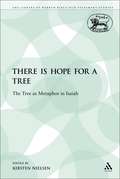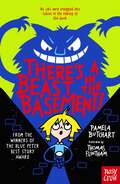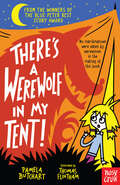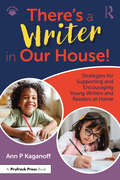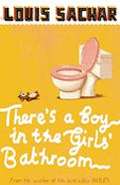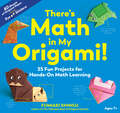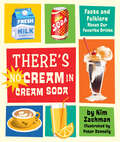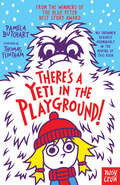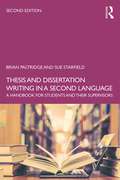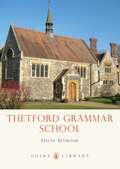- Table View
- List View
There is Hope for a Tree: The Tree as Metaphor in Isaiah (The Library of Hebrew Bible/Old Testament Studies)
by Kirsten NielsenInsights gained from the study of metaphorical language in other fields, particularly New Testament parable research, are here applied to the tree metaphors in Isaiah 1-39. The focus of investigation is the content of the metaphors , the intentions underlying their use, and the consequences of that use. The author suggests that (1) the informative function of the tree metaphors is to provide theological interpretations of the political situation; (2) the performative function of the metaphors is to engage the audience in such a way that they adopt the metaphors' interpretation of reality as their own; (3) the use of metaphorical language encourages continual reinterpretation of the original proclamation. The tree in the Garden, the felling of trees, new growth of felled trees and the forest fire, are among the images Isaiah uses to make his political statements. He shows himself to be an extremely competent rhetorician in using these images to instil an active response in his audience. The modes in which the metaphors can be reinterpreted and reapplied in new contexts are perceived as significant not only for the composition of Isaiah, but for that of subsequent religious literature.
There Is No Need to Talk about This: Poetic Inquiry from the Art Therapy Studio (Transgressions #106)
by Karen O. WallaceThe mystery of Art Therapy is demystified in this book as the author offers an illuminating glimpse into her therapy practice. The author is deeply immersed in her own creative process and the respect, delicacy, and understanding that she provides her clients shines through. The poems embrace the painful aspects of her clients’ lives and show how by working skillfully and creatively with trauma, abuse and mental illness, her clients move forward into joy, well-being and wholeness. Her poetic reflections move us to appreciate how art can be used as an instrument of transformation by travelling through landscapes where words cannot go.“Art is unique in its ability to embrace and communicate complex, deep, and subtle aspects of emotional experience. And often the best way to reflect upon and understand these artistic processes is to respond to them with more, in the same medium or a different one. Karen Wallace convincingly does both in There Is No Need to Talk about This: Poetic Inquiry from the Art Therapy Studio. Artistic expressions and images are apt to be a few steps ahead of the analytic mind’s way of sorting things out. As an art therapist, she responds to visual imagery and studio environment by writing poems. Aligned with how perception and sensibility work, this language arguably offers a fuller sense of multifaceted processes of arts therapy than conventional clinical narratives. Poems hold contradictions, pare down excess verbiage, distill seeds, and ‘speak/The thoughts of humanness that mattered.’ This book will help therapists and researchers gain a more complete comprehension of their work and do something creative and life enhancing with the feelings it generates in them – living the process themselves as the most reliable way to bring it to others.” – Shaun McNiff is Lesley University’s first University Professor and author of many books including Imagination in Action: Secrets for Unleashing Creative Expression and Art as Research “Karen Wallace’s There Is No Need to Talk about This: Poetic Inquiry from the Art Therapy Studio is a profoundly moving work, therapeutic, evocative, wise, tender, feeling. It is painfully evocative in its words and imagery. There are lessons here for any reader who has ever had to look deeply into the darkness that lurks beneath the traumas of daily life. Karen Wallace teaches all of how to heal, how to love, how to move forward with dignity, and courage.” – Norman Denzin, Professor Emeritus of Sociology, University of Illinois at Urbana-Champaign, Editor of Qualitative Inquiry and International Review of Qualitative Research“Our son Connor has autism and he saw Karen Wallace for art therapy for several years as a teen. Once he said, ‘Karen is the only one who understands me.’ She worked through many issues with him and helped us as parents decode his obsession with monsters. This book provides a glimpse into the genuine caring that Karen Wallace feels for every client lucky enough to see her.” – Kellie Garrett, ACC, MC, ICD.D, Speaker ~ Coach ~ Strategist
There Is No One Way to Teach Math: Actionable Ideas for Grades 6–12
by Robin Pemantle Henri PicciottoA collaboration between a seasoned math teacher and a research mathematician, this resource offers balanced instructional ideas based on student intellectual engagement and skilled teacher leadership. It is solidly grounded in many areas of classroom practice, but rather than serving as a prescriptive how-to manual, the authors invite reflection and discussion across classrooms and math departments, much in the way you would share ideas in the teachers’ lounge or across the table at a conference.Chapters offer practical suggestions and concrete examples to teachers of grades 6–12 on just about every aspect of the job: manipulatives, technology, lesson planning, group work, classroom discussion, and more. In opposition to the idea of a “one-size-fits-all” curriculum, the authors explain how to integrate teaching techniques: formal and informal, student-centered and teacher-led, experiential and rigorous.Chapters also include vignettes, as well as many links to curricular materials. Ideal for math educators of grades 6–12, this book is both comprehensive in its strategies and sensitive to the complexities of teaching. For these reasons, math departments, coaches, teacher leaders, and faculty at other levels can also easily reference its content where relevant. This book offers multiple entry points for teachers and departments to discuss and enhance their practice, making it essential reading for any math educator or professional development opportunity.
There Is No One Way to Teach Math: Actionable Ideas for Grades 6–12
by Robin Pemantle Henri PicciottoA collaboration between a seasoned math teacher and a research mathematician, this resource offers balanced instructional ideas based on student intellectual engagement and skilled teacher leadership. It is solidly grounded in many areas of classroom practice, but rather than serving as a prescriptive how-to manual, the authors invite reflection and discussion across classrooms and math departments, much in the way you would share ideas in the teachers’ lounge or across the table at a conference.Chapters offer practical suggestions and concrete examples to teachers of grades 6–12 on just about every aspect of the job: manipulatives, technology, lesson planning, group work, classroom discussion, and more. In opposition to the idea of a “one-size-fits-all” curriculum, the authors explain how to integrate teaching techniques: formal and informal, student-centered and teacher-led, experiential and rigorous.Chapters also include vignettes, as well as many links to curricular materials. Ideal for math educators of grades 6–12, this book is both comprehensive in its strategies and sensitive to the complexities of teaching. For these reasons, math departments, coaches, teacher leaders, and faculty at other levels can also easily reference its content where relevant. This book offers multiple entry points for teachers and departments to discuss and enhance their practice, making it essential reading for any math educator or professional development opportunity.
There’s a Beast in the Basement! (Baby Aliens #13)
by Pamela ButchartHilarious, pitch-perfect stories where everyday school life becomes completely extraordinary! By the brilliant Blue Peter-award winning team of Pamela Butchart and Thomas Flintham, the best in the business! Chaos and mayhem reign as Izzy and her friends take on another hilarious (mis)adventure. There's no such thing as an ordinary day at school when they're around... Izzy and her friends overhear their head teacher talking about "missing treasure" and "running out of time". They know this means there's TREASURE buried in the school somewhere and that Mr Graves wants it all for himself. So Jodi says they've got to find it first, and they should start by searching the staffroom. After seeing things they will never forget, they head to the basement. Gary Petrie's dad is working down there and he's seen something SHINY! So they send Zach's cat down with a camera strapped to her head and study the footage carefully. What they see is SHOCKING and CHANGES EVERYTHING. It's not treasure in the basement, it's a BEAST with SHINING EYES and it's coming to get them! RUN!!!
There's a Werewolf In My Tent! (Baby Aliens)
by Pamela ButchartIzzy and her friends are SO EXCITED about their school trip. They're going camping and there'll be marshmallows and no washing and everything. But then WEIRD things start happening! There are howling sounds at night, and some sausages have gone missing, and it's nearly a full moon... But it's when they see their new teacher's hairy legs that they KNOW! There's a werewolf on the school trip and they're all DOOMED! Another brilliantly funny longer read for the newly confident reader from the best-selling, award-winning, author-illustrator team, Pamela Butchart and Thomas Flintham.
There's a Writer in Our House! Strategies for Supporting and Encouraging Young Writers and Readers at Home
by Ann P. KaganoffThere’s a Writer in Our House! is an invitation to parents of children in first grade through fifth grade interested in actively participating in their children’s early literacy learning from the very first steps.Founded upon well-researched literacy instructional methods that have been informed by the author’s clinical perspective as well as her years of experience with many kinds of learners, this book provides a valuable understanding of how both writing and reading contribute to child development in multiple areas. Chapters provide background concepts regarding grammar and specific critical thinking skills in both writing and reading as well as customizable, child-centered activities used to practice and build writing and reading comprehension skills.You will learn how to advance and encourage your child’s learning and communication skills by highlighting important literacy areas such as vocabulary development, background knowledge, and critical thinking. You will also learn to recognize and track the significant developmental achievements of your child as you proceed from the early to the more complex At-Home activities, as well as receive strategies for how to respond and give feedback in specific situations, such as when a child writes something that makes sense to the child but not to the parent, how to offer feedback that identifies and labels a child’s strengths, and how to collaborate effectively with a child who is just developing new interests or a new willingness to try something that previously seemed “hard.”Practical, accessible, and most importantly, fun, this book is a must-read for all parents, regardless of background, seeking to support their children’s ongoing literacy development confidently and effectively.
There's a Writer in Our House! Strategies for Supporting and Encouraging Young Writers and Readers at Home
by Ann P. KaganoffThere’s a Writer in Our House! is an invitation to parents of children in first grade through fifth grade interested in actively participating in their children’s early literacy learning from the very first steps.Founded upon well-researched literacy instructional methods that have been informed by the author’s clinical perspective as well as her years of experience with many kinds of learners, this book provides a valuable understanding of how both writing and reading contribute to child development in multiple areas. Chapters provide background concepts regarding grammar and specific critical thinking skills in both writing and reading as well as customizable, child-centered activities used to practice and build writing and reading comprehension skills.You will learn how to advance and encourage your child’s learning and communication skills by highlighting important literacy areas such as vocabulary development, background knowledge, and critical thinking. You will also learn to recognize and track the significant developmental achievements of your child as you proceed from the early to the more complex At-Home activities, as well as receive strategies for how to respond and give feedback in specific situations, such as when a child writes something that makes sense to the child but not to the parent, how to offer feedback that identifies and labels a child’s strengths, and how to collaborate effectively with a child who is just developing new interests or a new willingness to try something that previously seemed “hard.”Practical, accessible, and most importantly, fun, this book is a must-read for all parents, regardless of background, seeking to support their children’s ongoing literacy development confidently and effectively.
There's A Boy In The Girls' Bathroom (PDF)
by Louis SacharBradley Chalkers is a bad lot He lies, he gets into fights, no one wants to be his friend and he is all alone. Until, that is, he meets the delightful new school counsellor, Carla, and she persuades Bradley that he can change.
There's Math in My Origami!: 35 Fun Projects for Hands-On Math Learning
by Fumiaki Shingu35 creative origami designs plus brain-teasing math questions add up to the perfect math activity for kids Discover how fractions, shapes, and symmetry turn a flat sheet of paper into a 3D work of art! Each one of the 35 amazing projects in There&’s Math in My Origami!invites kids to: Follow the simple, step-by-step instructionsFlex their math skills by answering a fun quiz questionFold adorable origami like they&’ve never seen before! Includes educational projects for kids ages 7 and up—plus 2 pages of eye stickers, and 80 sheets of origami paper!
There's No Cream in Cream Soda: Facts and Folklore About Our Favorite Drinks
by Kim ZachmanFrom soda to water to milk and juice, this refreshing follow-up to There's No Ham in Hamburgers is full of fun facts and origin stories of some of America&’s most popular drinks. People have been inventing drinks for thousands of years. Kinda weird when you consider that humans only need two liquids to survive—water and milk—and we don&’t need milk once we can eat solid foods. So, why did humans, unlike other mammals, begin concocting new beverages? It likely started with safety—boiling water to make it safer to drink, and then adding in berries or leaves or roots to make it taste better. Sometimes, it was thought that enhancing drinks made them healthier (i.e. bubbly water restored vitality). Did you know that some of the most popular sodas were created by pharmacists? Americans spend approximately $150 billion on soft drinks, coffee, and tea each year. Why? This book offers some possible answers!
There's A Yeti In The Playground! (Baby Aliens)
by Pamela ButchartIzzy and friends are excited! The snow is falling fast and they're hoping they'll all be sent home early. But then they hear weird noises in the playground, and find a big footprint in the snow... And that's when they know! There's a YETI in the playground and it's HUNGRY! Laugh-out-loud fun from Blue Peter Award winners Pamela Butchart and Thomas Flintham."Izzy and friends are snowed in at school when they see a really big footprint... A seasonal instalment in the brilliantly funny series for young readers." - The Bookseller
Theresa May, The Hostile Environment and Public Pedagogies of Hate and Threat: The Case for a Future Without Borders (Routledge Research in Education Policy and Politics)
by Mike ColeTheresa May, The Hostile Environment and Public Pedagogies of Hate and Threat analyses Theresa May’s involvement in the creation and promotion of public pedagogies of hate and threat around the issue of immigration, which are used to instil fear, stress and anxiety among large sections of the population. This book uses public pedagogy as a theoretical lens and examines the economic and political backdrop to the hostile environment, before moving on to a consideration of its creation and consolidation by Theresa May as Home Secretary and later as Prime Minister. The effects of the hostile environment on health and education are addressed, as well as its specific impacts on asylum seekers and women. The book also interrogates the Windrush scandal and divided families, as well as the author and his family's personal experiences of the hostile environment. It concludes by considering the escalation of racism in general, the crisis in neoliberalism, and the case for a socialist future without borders. This topical book will appeal to doctoral, postgraduate and advanced undergraduate students in the fields of education studies, pedagogy and sociology as well as those interested in UK politics.
Theresa May, The Hostile Environment and Public Pedagogies of Hate and Threat: The Case for a Future Without Borders (Routledge Research in Education Policy and Politics)
by Mike ColeTheresa May, The Hostile Environment and Public Pedagogies of Hate and Threat analyses Theresa May’s involvement in the creation and promotion of public pedagogies of hate and threat around the issue of immigration, which are used to instil fear, stress and anxiety among large sections of the population. This book uses public pedagogy as a theoretical lens and examines the economic and political backdrop to the hostile environment, before moving on to a consideration of its creation and consolidation by Theresa May as Home Secretary and later as Prime Minister. The effects of the hostile environment on health and education are addressed, as well as its specific impacts on asylum seekers and women. The book also interrogates the Windrush scandal and divided families, as well as the author and his family's personal experiences of the hostile environment. It concludes by considering the escalation of racism in general, the crisis in neoliberalism, and the case for a socialist future without borders. This topical book will appeal to doctoral, postgraduate and advanced undergraduate students in the fields of education studies, pedagogy and sociology as well as those interested in UK politics.
Thermal Cameras in Science Education (Innovations in Science Education and Technology #26)
by Jesper Haglund Fredrik Jeppsson Konrad J. SchönbornThis book presents a collection of educational research and developmental efforts on the rapidly emerging use of infrared cameras and thermal imaging in science education. It provides an overview of infrared cameras in science education to date, and of the physics and technology of infrared imaging and thermography. It discusses different areas of application of infrared cameras in physics, chemistry and biology education, as well as empirical research on students’ interaction with the technology. It ends with conclusions drawn from the contributions as a whole and a formulation of forward-looking comments.
These are the Generations: Identity, Covenant, and the 'toledot' Formula (The Library of Hebrew Bible/Old Testament Studies)
by Matthew A. ThomasUsing a combination of form-critical and linguistic methods, the author seeks to understand the role of the toledot formula, often translated "These are the generations of Name," in shaping the book of Genesis and the Pentateuch as a whole. An examination of the formula uncovers that it functions primarily as a heading to major sections of text and draws the readers' attention to focus on an ever narrower range of characters.By starting from the perspective of the surface structure of the text and addressing questions that investigation raises, the study is able to uncover and resolve a number of tensions within the text, as well as provide insights into a number of other questions surrounding the toledot headings and the organization of the structure of the Pentateuch.
These Kids: Identity, Agency, and Social Justice at a Last Chance High School
by Kysa NygreenFew would deny that getting ahead is a legitimate goal of learning, but the phrase implies a cruel hierarchy: a student does not simply get ahead, but gets ahead of others. In These Kids, Kysa Nygreen turns a critical eye on this paradox. Offering the voices and viewpoints of students at a “last chance” high school in California, she tells the story of students who have, in fact, been left behind. Detailing a youth-led participatory action research project that she coordinated, Nygreen uncovers deep barriers to educational success that are embedded within educational discourse itself. Struggling students internalize descriptions of themselves as “at risk,” “low achieving,” or “troubled”—and by adopting the very language of educators, they also adopt its constraints and presumption of failure. Showing how current educational discourse does not, ultimately, provide an adequate vision of change for students at the bottom of the educational hierarchy, she levies a powerful argument that social justice in education is impossible today precisely because of how we talk about it.
These Kids: Identity, Agency, and Social Justice at a Last Chance High School
by Kysa NygreenFew would deny that getting ahead is a legitimate goal of learning, but the phrase implies a cruel hierarchy: a student does not simply get ahead, but gets ahead of others. In These Kids, Kysa Nygreen turns a critical eye on this paradox. Offering the voices and viewpoints of students at a “last chance” high school in California, she tells the story of students who have, in fact, been left behind. Detailing a youth-led participatory action research project that she coordinated, Nygreen uncovers deep barriers to educational success that are embedded within educational discourse itself. Struggling students internalize descriptions of themselves as “at risk,” “low achieving,” or “troubled”—and by adopting the very language of educators, they also adopt its constraints and presumption of failure. Showing how current educational discourse does not, ultimately, provide an adequate vision of change for students at the bottom of the educational hierarchy, she levies a powerful argument that social justice in education is impossible today precisely because of how we talk about it.
These Kids: Identity, Agency, and Social Justice at a Last Chance High School
by Kysa NygreenFew would deny that getting ahead is a legitimate goal of learning, but the phrase implies a cruel hierarchy: a student does not simply get ahead, but gets ahead of others. In These Kids, Kysa Nygreen turns a critical eye on this paradox. Offering the voices and viewpoints of students at a “last chance” high school in California, she tells the story of students who have, in fact, been left behind. Detailing a youth-led participatory action research project that she coordinated, Nygreen uncovers deep barriers to educational success that are embedded within educational discourse itself. Struggling students internalize descriptions of themselves as “at risk,” “low achieving,” or “troubled”—and by adopting the very language of educators, they also adopt its constraints and presumption of failure. Showing how current educational discourse does not, ultimately, provide an adequate vision of change for students at the bottom of the educational hierarchy, she levies a powerful argument that social justice in education is impossible today precisely because of how we talk about it.
These Kids: Identity, Agency, and Social Justice at a Last Chance High School
by Kysa NygreenFew would deny that getting ahead is a legitimate goal of learning, but the phrase implies a cruel hierarchy: a student does not simply get ahead, but gets ahead of others. In These Kids, Kysa Nygreen turns a critical eye on this paradox. Offering the voices and viewpoints of students at a “last chance” high school in California, she tells the story of students who have, in fact, been left behind. Detailing a youth-led participatory action research project that she coordinated, Nygreen uncovers deep barriers to educational success that are embedded within educational discourse itself. Struggling students internalize descriptions of themselves as “at risk,” “low achieving,” or “troubled”—and by adopting the very language of educators, they also adopt its constraints and presumption of failure. Showing how current educational discourse does not, ultimately, provide an adequate vision of change for students at the bottom of the educational hierarchy, she levies a powerful argument that social justice in education is impossible today precisely because of how we talk about it.
These Kids: Identity, Agency, and Social Justice at a Last Chance High School
by Kysa NygreenFew would deny that getting ahead is a legitimate goal of learning, but the phrase implies a cruel hierarchy: a student does not simply get ahead, but gets ahead of others. In These Kids, Kysa Nygreen turns a critical eye on this paradox. Offering the voices and viewpoints of students at a “last chance” high school in California, she tells the story of students who have, in fact, been left behind. Detailing a youth-led participatory action research project that she coordinated, Nygreen uncovers deep barriers to educational success that are embedded within educational discourse itself. Struggling students internalize descriptions of themselves as “at risk,” “low achieving,” or “troubled”—and by adopting the very language of educators, they also adopt its constraints and presumption of failure. Showing how current educational discourse does not, ultimately, provide an adequate vision of change for students at the bottom of the educational hierarchy, she levies a powerful argument that social justice in education is impossible today precisely because of how we talk about it.
These Kids: Identity, Agency, and Social Justice at a Last Chance High School
by Kysa NygreenFew would deny that getting ahead is a legitimate goal of learning, but the phrase implies a cruel hierarchy: a student does not simply get ahead, but gets ahead of others. In These Kids, Kysa Nygreen turns a critical eye on this paradox. Offering the voices and viewpoints of students at a “last chance” high school in California, she tells the story of students who have, in fact, been left behind. Detailing a youth-led participatory action research project that she coordinated, Nygreen uncovers deep barriers to educational success that are embedded within educational discourse itself. Struggling students internalize descriptions of themselves as “at risk,” “low achieving,” or “troubled”—and by adopting the very language of educators, they also adopt its constraints and presumption of failure. Showing how current educational discourse does not, ultimately, provide an adequate vision of change for students at the bottom of the educational hierarchy, she levies a powerful argument that social justice in education is impossible today precisely because of how we talk about it.
Thesis and Dissertation Writing in a Second Language: A Handbook for Students and their Supervisors
by Brian Paltridge Sue StarfieldFully updated and packed with new material, the second edition of Thesis and Dissertation Writing in a Second Language is the ideal guide for non-native speaker students and their supervisors working on writing a thesis or dissertation in English. Considering the purposes of thesis and dissertation of writing alongside writer/reader relationships, this book uses accessible language and practical examples to discuss issues that are crucial to successful thesis and dissertation writing. This edition offers: Insights into the experience of being a doctoral writer, issues of writer identity, and writing with authority Typical language and discourse features of theses and dissertations Advice on the structure and organisation of key sections Suggestions for online resources which support writing Extracts from completed theses and dissertations Guidance on understanding examiner expectations Advice on publishing from a PhD Suitable for students from all disciplines, Thesis and Dissertation Writing in a Second Language is essential reading for non-native speaker students looking to complete a thesis or dissertation in English.
Thesis and Dissertation Writing in a Second Language: A Handbook for Students and their Supervisors
by Brian Paltridge Sue StarfieldFully updated and packed with new material, the second edition of Thesis and Dissertation Writing in a Second Language is the ideal guide for non-native speaker students and their supervisors working on writing a thesis or dissertation in English. Considering the purposes of thesis and dissertation of writing alongside writer/reader relationships, this book uses accessible language and practical examples to discuss issues that are crucial to successful thesis and dissertation writing. This edition offers: Insights into the experience of being a doctoral writer, issues of writer identity, and writing with authority Typical language and discourse features of theses and dissertations Advice on the structure and organisation of key sections Suggestions for online resources which support writing Extracts from completed theses and dissertations Guidance on understanding examiner expectations Advice on publishing from a PhD Suitable for students from all disciplines, Thesis and Dissertation Writing in a Second Language is essential reading for non-native speaker students looking to complete a thesis or dissertation in English.
Thetford Grammar School: Fourteen Centuries Of Education In East Anglia
by David SeymourThetford Grammar School's formation is shrouded in mystery, but it may date back as far as 631. First re-founded by the Bishop of Norwich in 1114, the school was revitalised following the dissolution of the monasteries, and firmly re-established by an Act of Parliament in 1610 and then by a new foundation document in 1876. A Girls' School was set up alongside the ancient Boys' School in 1888 and both schools spent the middle years of the twentieth century as county council grammar schools, before their re-foundation as a co-educational independent school in 1981. Written to coincide with the 450th anniversary of Thetford Grammar School's re-founding and drawing on the school's archives, David Seymour discusses four and a half centuries of governance, pupils, headteachers, ushers and assistant teachers, phases of building, and the development of the curriculum.
